Impact of Political Instability and Terrorism on Kenyan Tourism
VerifiedAdded on 2023/01/18
|18
|4512
|28
Report
AI Summary
This report meticulously analyzes the significant impact of political instability and terrorism on Kenya's tourism and hospitality sector, with a specific focus on the coastal region, including key destinations such as Mombasa, Diani, Malindi, and Watamu. It provides a comprehensive background of violence and tourism in the region, detailing the effects of events like post-election clashes, Al-Shabaab attacks, and political assassinations. The report examines the challenges, including decreased foreign visitor numbers and decline in bookings, and proposes innovative solutions such as declaring a crisis and establishing guidelines for managing violence. Furthermore, it explores the broader implications, considering spatial spillover effects and poor international tourism demand, while also addressing ethical and social issues from diverse stakeholder perspectives. The report concludes with a discussion of the importance of tourism and hospitality to the Kenyan economy and the need for proactive measures to mitigate the negative impacts of instability and terrorism.
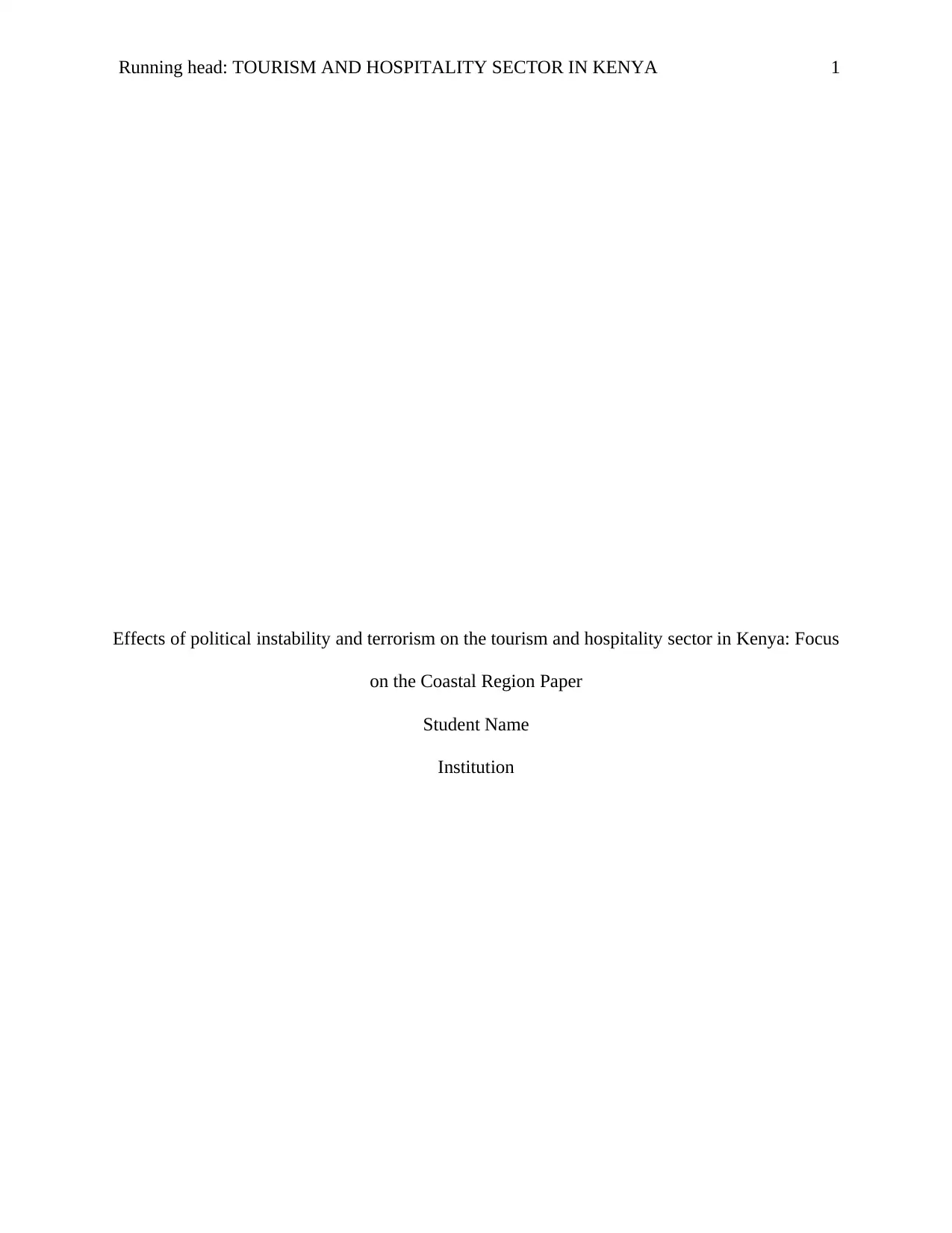
Running head: TOURISM AND HOSPITALITY SECTOR IN KENYA 1
Effects of political instability and terrorism on the tourism and hospitality sector in Kenya: Focus
on the Coastal Region Paper
Student Name
Institution
Effects of political instability and terrorism on the tourism and hospitality sector in Kenya: Focus
on the Coastal Region Paper
Student Name
Institution
Paraphrase This Document
Need a fresh take? Get an instant paraphrase of this document with our AI Paraphraser
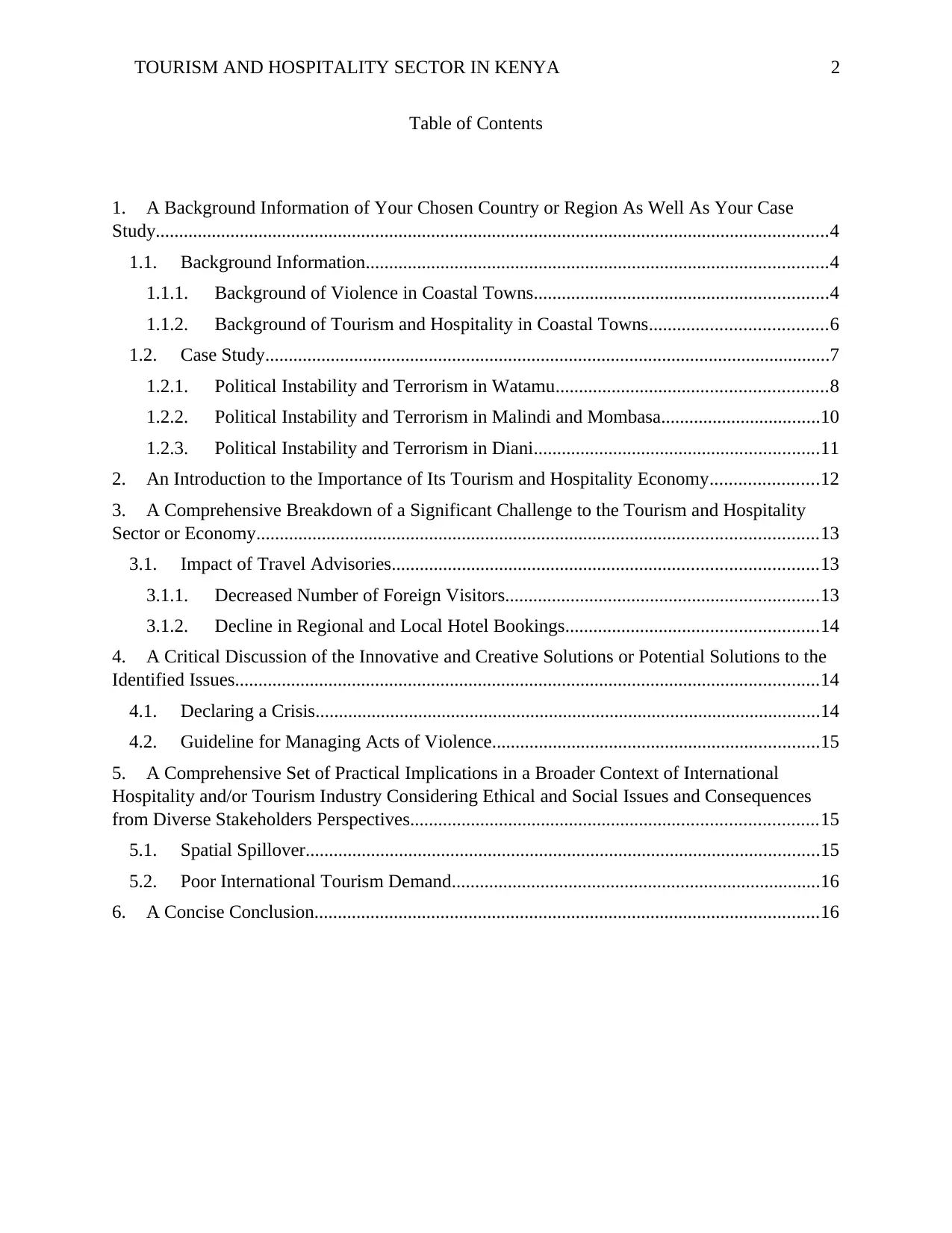
TOURISM AND HOSPITALITY SECTOR IN KENYA 2
Table of Contents
1. A Background Information of Your Chosen Country or Region As Well As Your Case
Study................................................................................................................................................4
1.1. Background Information...................................................................................................4
1.1.1. Background of Violence in Coastal Towns...............................................................4
1.1.2. Background of Tourism and Hospitality in Coastal Towns......................................6
1.2. Case Study.........................................................................................................................7
1.2.1. Political Instability and Terrorism in Watamu..........................................................8
1.2.2. Political Instability and Terrorism in Malindi and Mombasa..................................10
1.2.3. Political Instability and Terrorism in Diani.............................................................11
2. An Introduction to the Importance of Its Tourism and Hospitality Economy.......................12
3. A Comprehensive Breakdown of a Significant Challenge to the Tourism and Hospitality
Sector or Economy........................................................................................................................13
3.1. Impact of Travel Advisories...........................................................................................13
3.1.1. Decreased Number of Foreign Visitors...................................................................13
3.1.2. Decline in Regional and Local Hotel Bookings......................................................14
4. A Critical Discussion of the Innovative and Creative Solutions or Potential Solutions to the
Identified Issues.............................................................................................................................14
4.1. Declaring a Crisis............................................................................................................14
4.2. Guideline for Managing Acts of Violence......................................................................15
5. A Comprehensive Set of Practical Implications in a Broader Context of International
Hospitality and/or Tourism Industry Considering Ethical and Social Issues and Consequences
from Diverse Stakeholders Perspectives.......................................................................................15
5.1. Spatial Spillover..............................................................................................................15
5.2. Poor International Tourism Demand...............................................................................16
6. A Concise Conclusion............................................................................................................16
Table of Contents
1. A Background Information of Your Chosen Country or Region As Well As Your Case
Study................................................................................................................................................4
1.1. Background Information...................................................................................................4
1.1.1. Background of Violence in Coastal Towns...............................................................4
1.1.2. Background of Tourism and Hospitality in Coastal Towns......................................6
1.2. Case Study.........................................................................................................................7
1.2.1. Political Instability and Terrorism in Watamu..........................................................8
1.2.2. Political Instability and Terrorism in Malindi and Mombasa..................................10
1.2.3. Political Instability and Terrorism in Diani.............................................................11
2. An Introduction to the Importance of Its Tourism and Hospitality Economy.......................12
3. A Comprehensive Breakdown of a Significant Challenge to the Tourism and Hospitality
Sector or Economy........................................................................................................................13
3.1. Impact of Travel Advisories...........................................................................................13
3.1.1. Decreased Number of Foreign Visitors...................................................................13
3.1.2. Decline in Regional and Local Hotel Bookings......................................................14
4. A Critical Discussion of the Innovative and Creative Solutions or Potential Solutions to the
Identified Issues.............................................................................................................................14
4.1. Declaring a Crisis............................................................................................................14
4.2. Guideline for Managing Acts of Violence......................................................................15
5. A Comprehensive Set of Practical Implications in a Broader Context of International
Hospitality and/or Tourism Industry Considering Ethical and Social Issues and Consequences
from Diverse Stakeholders Perspectives.......................................................................................15
5.1. Spatial Spillover..............................................................................................................15
5.2. Poor International Tourism Demand...............................................................................16
6. A Concise Conclusion............................................................................................................16
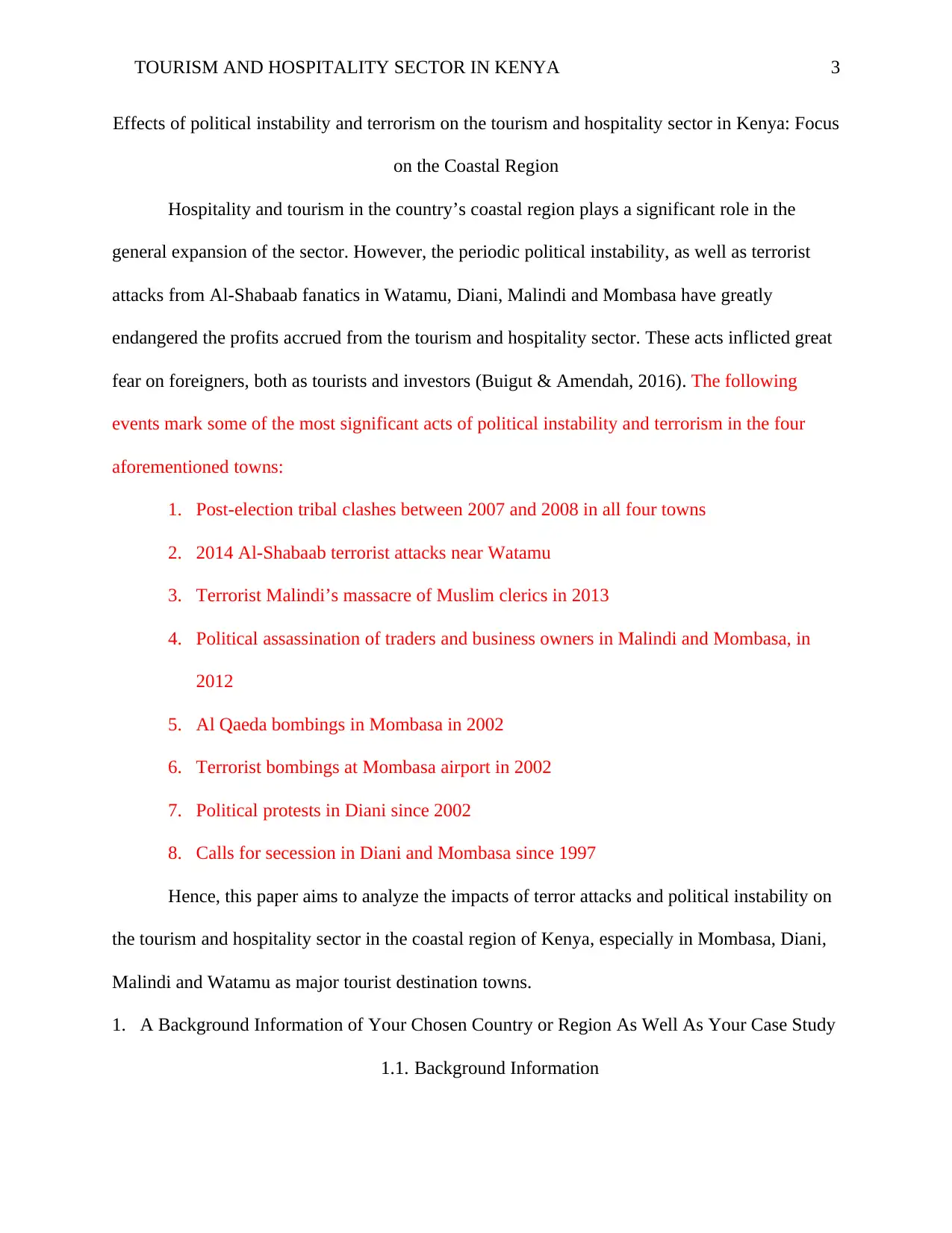
TOURISM AND HOSPITALITY SECTOR IN KENYA 3
Effects of political instability and terrorism on the tourism and hospitality sector in Kenya: Focus
on the Coastal Region
Hospitality and tourism in the country’s coastal region plays a significant role in the
general expansion of the sector. However, the periodic political instability, as well as terrorist
attacks from Al-Shabaab fanatics in Watamu, Diani, Malindi and Mombasa have greatly
endangered the profits accrued from the tourism and hospitality sector. These acts inflicted great
fear on foreigners, both as tourists and investors (Buigut & Amendah, 2016). The following
events mark some of the most significant acts of political instability and terrorism in the four
aforementioned towns:
1. Post-election tribal clashes between 2007 and 2008 in all four towns
2. 2014 Al-Shabaab terrorist attacks near Watamu
3. Terrorist Malindi’s massacre of Muslim clerics in 2013
4. Political assassination of traders and business owners in Malindi and Mombasa, in
2012
5. Al Qaeda bombings in Mombasa in 2002
6. Terrorist bombings at Mombasa airport in 2002
7. Political protests in Diani since 2002
8. Calls for secession in Diani and Mombasa since 1997
Hence, this paper aims to analyze the impacts of terror attacks and political instability on
the tourism and hospitality sector in the coastal region of Kenya, especially in Mombasa, Diani,
Malindi and Watamu as major tourist destination towns.
1. A Background Information of Your Chosen Country or Region As Well As Your Case Study
1.1. Background Information
Effects of political instability and terrorism on the tourism and hospitality sector in Kenya: Focus
on the Coastal Region
Hospitality and tourism in the country’s coastal region plays a significant role in the
general expansion of the sector. However, the periodic political instability, as well as terrorist
attacks from Al-Shabaab fanatics in Watamu, Diani, Malindi and Mombasa have greatly
endangered the profits accrued from the tourism and hospitality sector. These acts inflicted great
fear on foreigners, both as tourists and investors (Buigut & Amendah, 2016). The following
events mark some of the most significant acts of political instability and terrorism in the four
aforementioned towns:
1. Post-election tribal clashes between 2007 and 2008 in all four towns
2. 2014 Al-Shabaab terrorist attacks near Watamu
3. Terrorist Malindi’s massacre of Muslim clerics in 2013
4. Political assassination of traders and business owners in Malindi and Mombasa, in
2012
5. Al Qaeda bombings in Mombasa in 2002
6. Terrorist bombings at Mombasa airport in 2002
7. Political protests in Diani since 2002
8. Calls for secession in Diani and Mombasa since 1997
Hence, this paper aims to analyze the impacts of terror attacks and political instability on
the tourism and hospitality sector in the coastal region of Kenya, especially in Mombasa, Diani,
Malindi and Watamu as major tourist destination towns.
1. A Background Information of Your Chosen Country or Region As Well As Your Case Study
1.1. Background Information
⊘ This is a preview!⊘
Do you want full access?
Subscribe today to unlock all pages.

Trusted by 1+ million students worldwide

TOURISM AND HOSPITALITY SECTOR IN KENYA 4
1.1.1. Background of Violence in Coastal Towns
Violence in the coastal region of Kenya is rather common and extensive. It often entails
common occurrences of gender-based and sexual vehemence, inter-communal and tribal attacks,
series of election-based violence, and the rising events of terrorist-related attacks. The nature and
severity of violence in Mombasa, Diani, Watamu and Malindi, as tourist destination towns, has
been on the rise over the recent years (Anderson & McKnight, 2014).
The aforementioned towns entail several ethnic communities, as represented in figure 1
below. The most common indigenous groups include Bantu, and Cushitic-speaking groups, such
as, the Borana, Burji, Orma, Sakuye, Garba, and Waata. While most of these groups often have
similar customs, they bear different values which sometimes prompt them into periodic clashes
(Neumayer & Plümper, 2016).
Figure 1: Ethno-Linguistic Minorities in Regional Kenya (WB, 2016)
1.1.1. Background of Violence in Coastal Towns
Violence in the coastal region of Kenya is rather common and extensive. It often entails
common occurrences of gender-based and sexual vehemence, inter-communal and tribal attacks,
series of election-based violence, and the rising events of terrorist-related attacks. The nature and
severity of violence in Mombasa, Diani, Watamu and Malindi, as tourist destination towns, has
been on the rise over the recent years (Anderson & McKnight, 2014).
The aforementioned towns entail several ethnic communities, as represented in figure 1
below. The most common indigenous groups include Bantu, and Cushitic-speaking groups, such
as, the Borana, Burji, Orma, Sakuye, Garba, and Waata. While most of these groups often have
similar customs, they bear different values which sometimes prompt them into periodic clashes
(Neumayer & Plümper, 2016).
Figure 1: Ethno-Linguistic Minorities in Regional Kenya (WB, 2016)
Paraphrase This Document
Need a fresh take? Get an instant paraphrase of this document with our AI Paraphraser
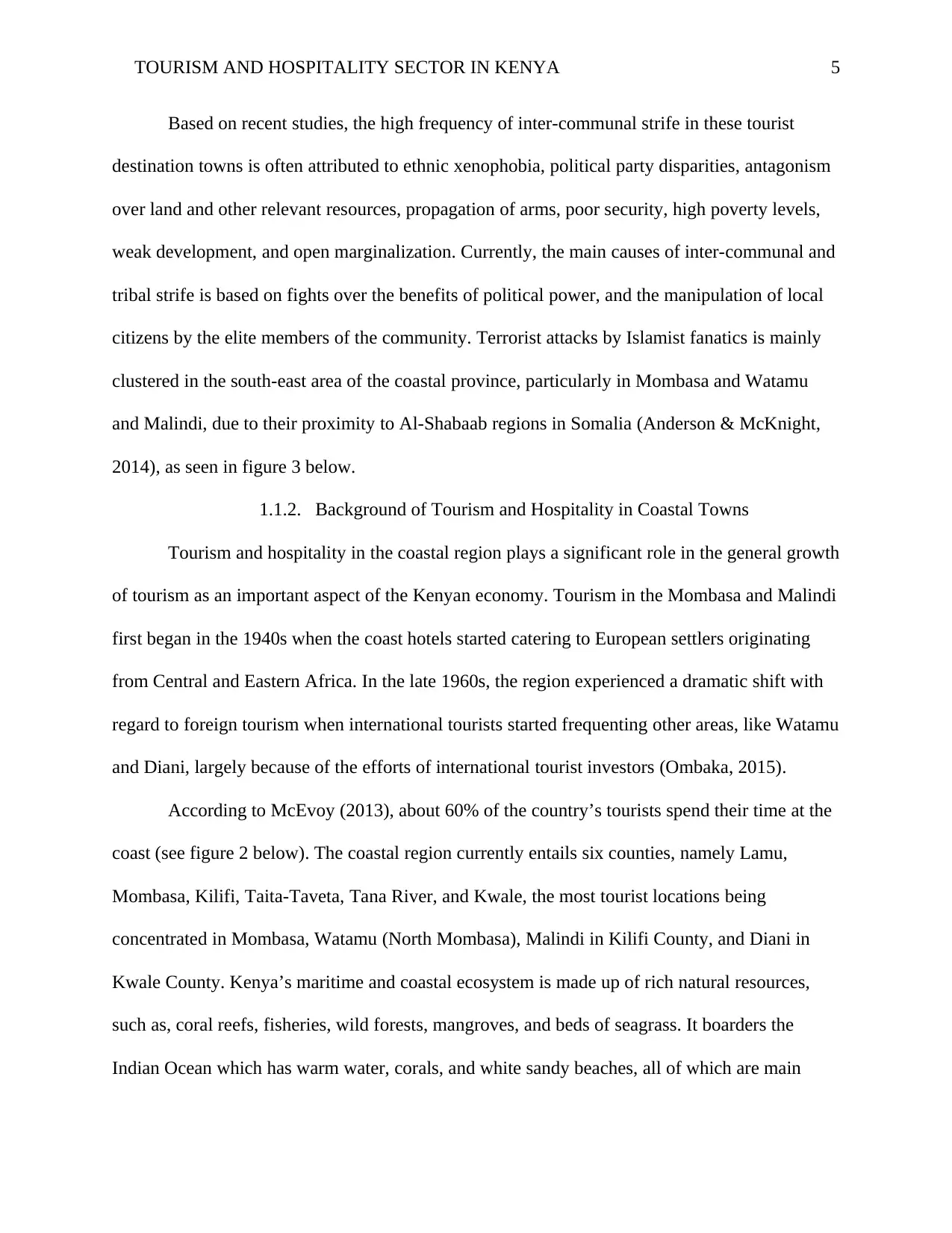
TOURISM AND HOSPITALITY SECTOR IN KENYA 5
Based on recent studies, the high frequency of inter-communal strife in these tourist
destination towns is often attributed to ethnic xenophobia, political party disparities, antagonism
over land and other relevant resources, propagation of arms, poor security, high poverty levels,
weak development, and open marginalization. Currently, the main causes of inter-communal and
tribal strife is based on fights over the benefits of political power, and the manipulation of local
citizens by the elite members of the community. Terrorist attacks by Islamist fanatics is mainly
clustered in the south-east area of the coastal province, particularly in Mombasa and Watamu
and Malindi, due to their proximity to Al-Shabaab regions in Somalia (Anderson & McKnight,
2014), as seen in figure 3 below.
1.1.2. Background of Tourism and Hospitality in Coastal Towns
Tourism and hospitality in the coastal region plays a significant role in the general growth
of tourism as an important aspect of the Kenyan economy. Tourism in the Mombasa and Malindi
first began in the 1940s when the coast hotels started catering to European settlers originating
from Central and Eastern Africa. In the late 1960s, the region experienced a dramatic shift with
regard to foreign tourism when international tourists started frequenting other areas, like Watamu
and Diani, largely because of the efforts of international tourist investors (Ombaka, 2015).
According to McEvoy (2013), about 60% of the country’s tourists spend their time at the
coast (see figure 2 below). The coastal region currently entails six counties, namely Lamu,
Mombasa, Kilifi, Taita-Taveta, Tana River, and Kwale, the most tourist locations being
concentrated in Mombasa, Watamu (North Mombasa), Malindi in Kilifi County, and Diani in
Kwale County. Kenya’s maritime and coastal ecosystem is made up of rich natural resources,
such as, coral reefs, fisheries, wild forests, mangroves, and beds of seagrass. It boarders the
Indian Ocean which has warm water, corals, and white sandy beaches, all of which are main
Based on recent studies, the high frequency of inter-communal strife in these tourist
destination towns is often attributed to ethnic xenophobia, political party disparities, antagonism
over land and other relevant resources, propagation of arms, poor security, high poverty levels,
weak development, and open marginalization. Currently, the main causes of inter-communal and
tribal strife is based on fights over the benefits of political power, and the manipulation of local
citizens by the elite members of the community. Terrorist attacks by Islamist fanatics is mainly
clustered in the south-east area of the coastal province, particularly in Mombasa and Watamu
and Malindi, due to their proximity to Al-Shabaab regions in Somalia (Anderson & McKnight,
2014), as seen in figure 3 below.
1.1.2. Background of Tourism and Hospitality in Coastal Towns
Tourism and hospitality in the coastal region plays a significant role in the general growth
of tourism as an important aspect of the Kenyan economy. Tourism in the Mombasa and Malindi
first began in the 1940s when the coast hotels started catering to European settlers originating
from Central and Eastern Africa. In the late 1960s, the region experienced a dramatic shift with
regard to foreign tourism when international tourists started frequenting other areas, like Watamu
and Diani, largely because of the efforts of international tourist investors (Ombaka, 2015).
According to McEvoy (2013), about 60% of the country’s tourists spend their time at the
coast (see figure 2 below). The coastal region currently entails six counties, namely Lamu,
Mombasa, Kilifi, Taita-Taveta, Tana River, and Kwale, the most tourist locations being
concentrated in Mombasa, Watamu (North Mombasa), Malindi in Kilifi County, and Diani in
Kwale County. Kenya’s maritime and coastal ecosystem is made up of rich natural resources,
such as, coral reefs, fisheries, wild forests, mangroves, and beds of seagrass. It boarders the
Indian Ocean which has warm water, corals, and white sandy beaches, all of which are main
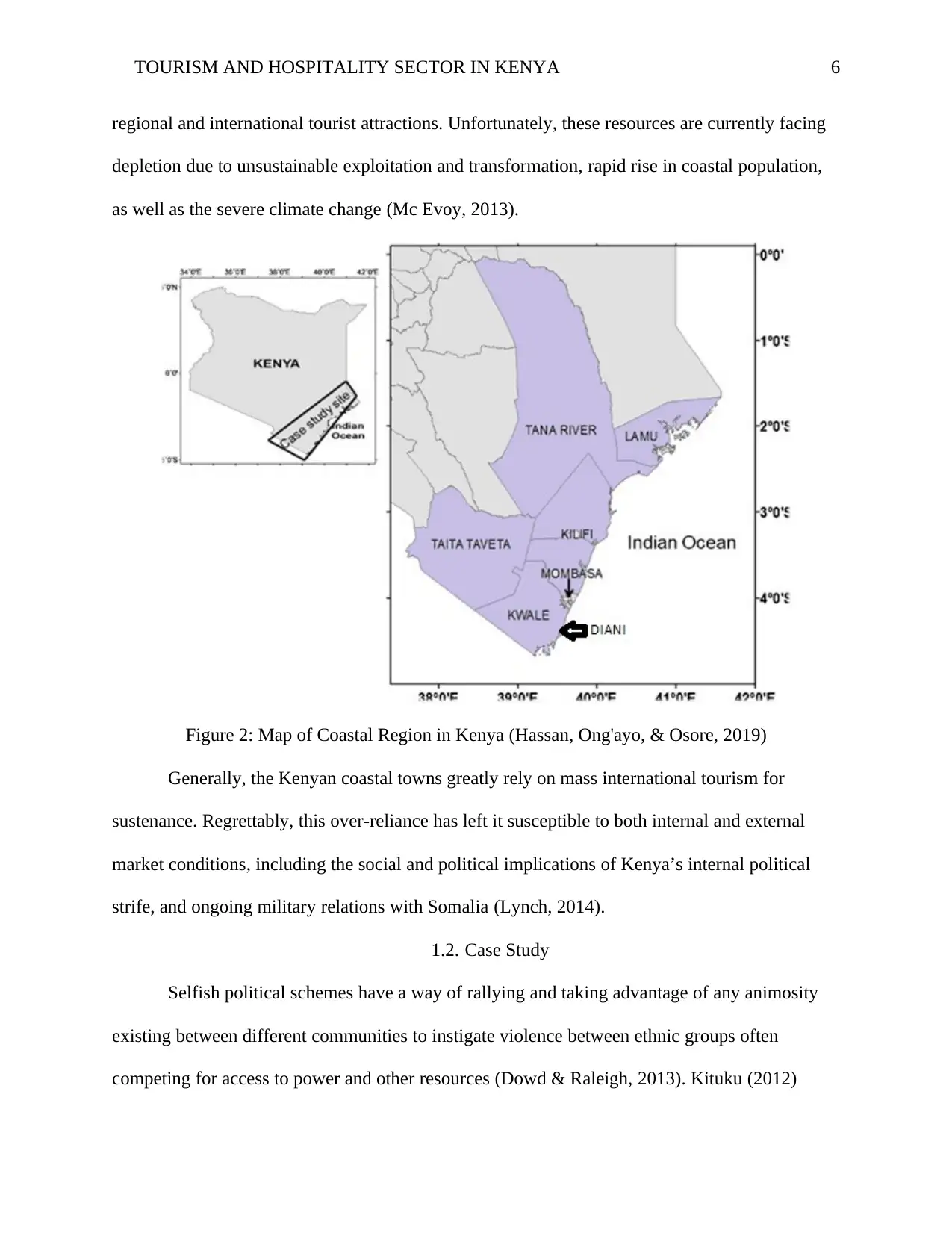
TOURISM AND HOSPITALITY SECTOR IN KENYA 6
regional and international tourist attractions. Unfortunately, these resources are currently facing
depletion due to unsustainable exploitation and transformation, rapid rise in coastal population,
as well as the severe climate change (Mc Evoy, 2013).
Figure 2: Map of Coastal Region in Kenya (Hassan, Ong'ayo, & Osore, 2019)
Generally, the Kenyan coastal towns greatly rely on mass international tourism for
sustenance. Regrettably, this over-reliance has left it susceptible to both internal and external
market conditions, including the social and political implications of Kenya’s internal political
strife, and ongoing military relations with Somalia (Lynch, 2014).
1.2. Case Study
Selfish political schemes have a way of rallying and taking advantage of any animosity
existing between different communities to instigate violence between ethnic groups often
competing for access to power and other resources (Dowd & Raleigh, 2013). Kituku (2012)
regional and international tourist attractions. Unfortunately, these resources are currently facing
depletion due to unsustainable exploitation and transformation, rapid rise in coastal population,
as well as the severe climate change (Mc Evoy, 2013).
Figure 2: Map of Coastal Region in Kenya (Hassan, Ong'ayo, & Osore, 2019)
Generally, the Kenyan coastal towns greatly rely on mass international tourism for
sustenance. Regrettably, this over-reliance has left it susceptible to both internal and external
market conditions, including the social and political implications of Kenya’s internal political
strife, and ongoing military relations with Somalia (Lynch, 2014).
1.2. Case Study
Selfish political schemes have a way of rallying and taking advantage of any animosity
existing between different communities to instigate violence between ethnic groups often
competing for access to power and other resources (Dowd & Raleigh, 2013). Kituku (2012)
⊘ This is a preview!⊘
Do you want full access?
Subscribe today to unlock all pages.

Trusted by 1+ million students worldwide
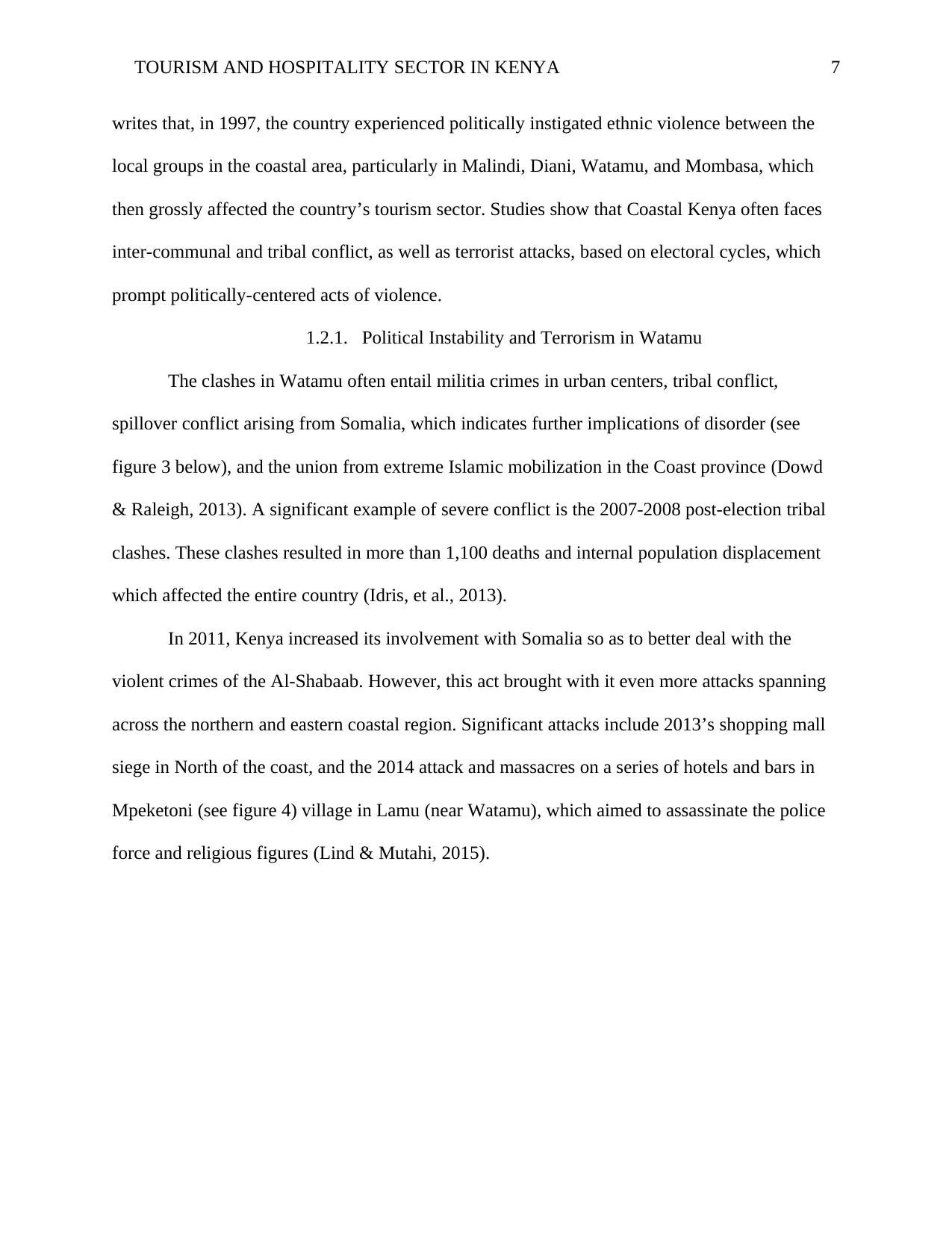
TOURISM AND HOSPITALITY SECTOR IN KENYA 7
writes that, in 1997, the country experienced politically instigated ethnic violence between the
local groups in the coastal area, particularly in Malindi, Diani, Watamu, and Mombasa, which
then grossly affected the country’s tourism sector. Studies show that Coastal Kenya often faces
inter-communal and tribal conflict, as well as terrorist attacks, based on electoral cycles, which
prompt politically-centered acts of violence.
1.2.1. Political Instability and Terrorism in Watamu
The clashes in Watamu often entail militia crimes in urban centers, tribal conflict,
spillover conflict arising from Somalia, which indicates further implications of disorder (see
figure 3 below), and the union from extreme Islamic mobilization in the Coast province (Dowd
& Raleigh, 2013). A significant example of severe conflict is the 2007-2008 post-election tribal
clashes. These clashes resulted in more than 1,100 deaths and internal population displacement
which affected the entire country (Idris, et al., 2013).
In 2011, Kenya increased its involvement with Somalia so as to better deal with the
violent crimes of the Al-Shabaab. However, this act brought with it even more attacks spanning
across the northern and eastern coastal region. Significant attacks include 2013’s shopping mall
siege in North of the coast, and the 2014 attack and massacres on a series of hotels and bars in
Mpeketoni (see figure 4) village in Lamu (near Watamu), which aimed to assassinate the police
force and religious figures (Lind & Mutahi, 2015).
writes that, in 1997, the country experienced politically instigated ethnic violence between the
local groups in the coastal area, particularly in Malindi, Diani, Watamu, and Mombasa, which
then grossly affected the country’s tourism sector. Studies show that Coastal Kenya often faces
inter-communal and tribal conflict, as well as terrorist attacks, based on electoral cycles, which
prompt politically-centered acts of violence.
1.2.1. Political Instability and Terrorism in Watamu
The clashes in Watamu often entail militia crimes in urban centers, tribal conflict,
spillover conflict arising from Somalia, which indicates further implications of disorder (see
figure 3 below), and the union from extreme Islamic mobilization in the Coast province (Dowd
& Raleigh, 2013). A significant example of severe conflict is the 2007-2008 post-election tribal
clashes. These clashes resulted in more than 1,100 deaths and internal population displacement
which affected the entire country (Idris, et al., 2013).
In 2011, Kenya increased its involvement with Somalia so as to better deal with the
violent crimes of the Al-Shabaab. However, this act brought with it even more attacks spanning
across the northern and eastern coastal region. Significant attacks include 2013’s shopping mall
siege in North of the coast, and the 2014 attack and massacres on a series of hotels and bars in
Mpeketoni (see figure 4) village in Lamu (near Watamu), which aimed to assassinate the police
force and religious figures (Lind & Mutahi, 2015).
Paraphrase This Document
Need a fresh take? Get an instant paraphrase of this document with our AI Paraphraser
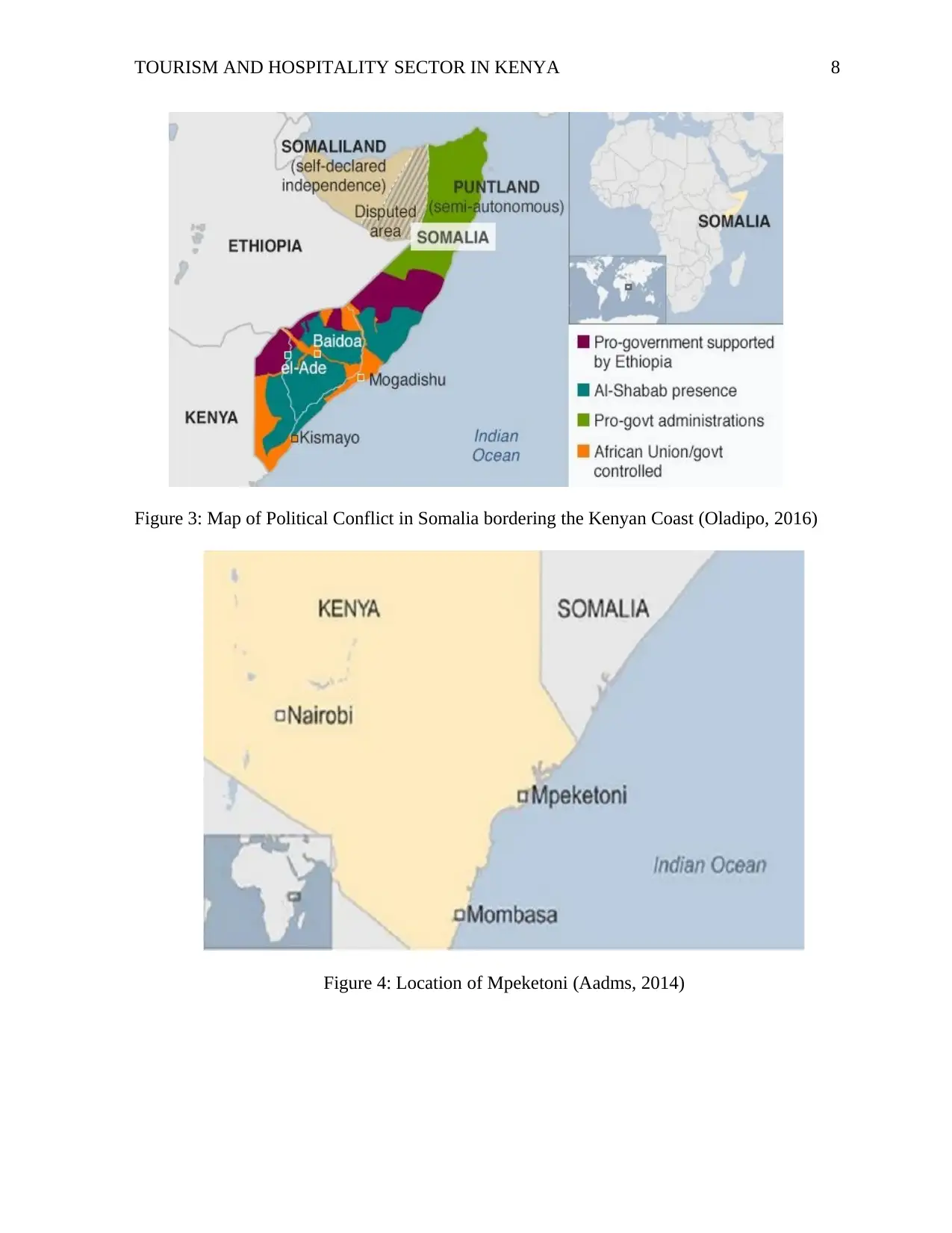
TOURISM AND HOSPITALITY SECTOR IN KENYA 8
Figure 3: Map of Political Conflict in Somalia bordering the Kenyan Coast (Oladipo, 2016)
Figure 4: Location of Mpeketoni (Aadms, 2014)
Figure 3: Map of Political Conflict in Somalia bordering the Kenyan Coast (Oladipo, 2016)
Figure 4: Location of Mpeketoni (Aadms, 2014)
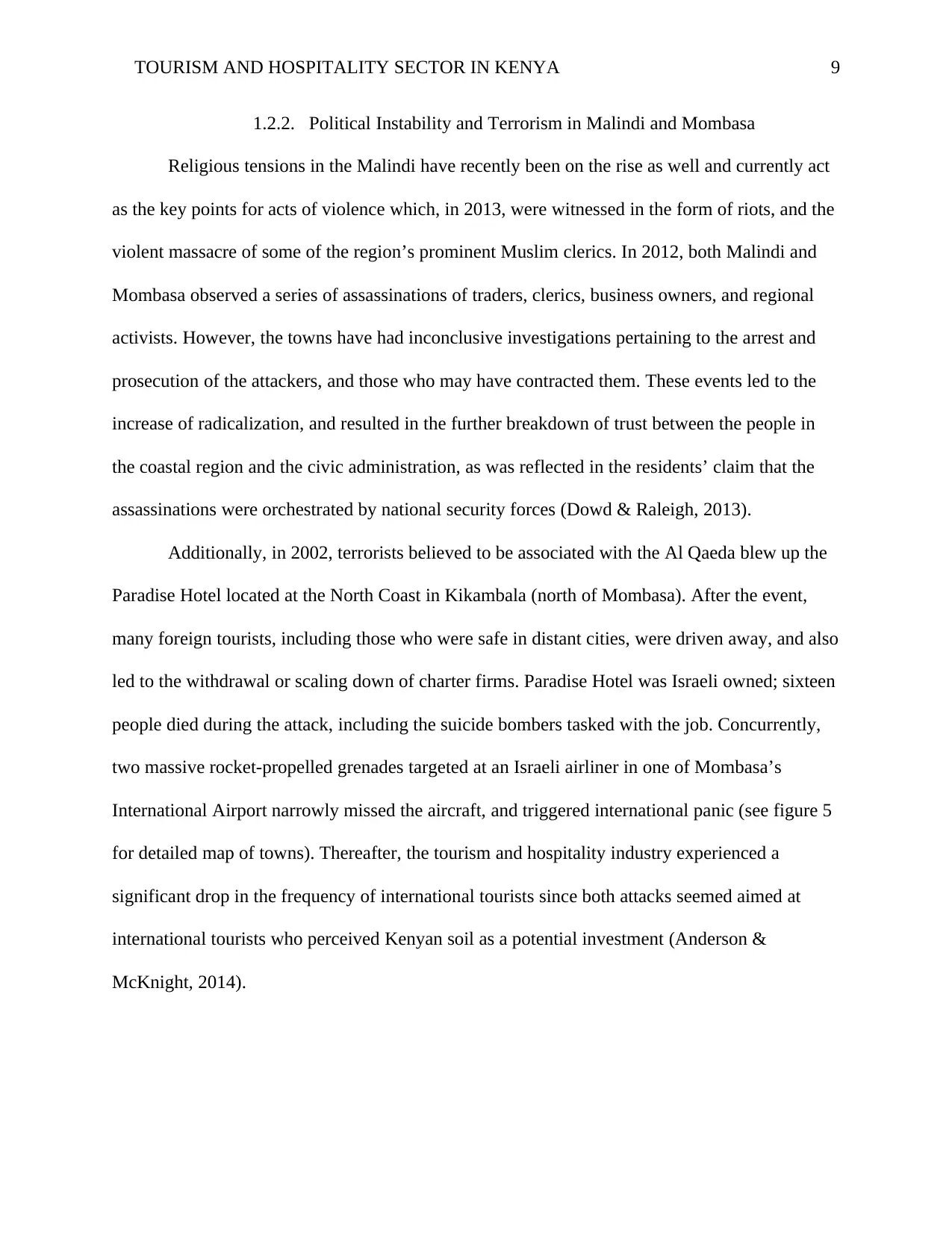
TOURISM AND HOSPITALITY SECTOR IN KENYA 9
1.2.2. Political Instability and Terrorism in Malindi and Mombasa
Religious tensions in the Malindi have recently been on the rise as well and currently act
as the key points for acts of violence which, in 2013, were witnessed in the form of riots, and the
violent massacre of some of the region’s prominent Muslim clerics. In 2012, both Malindi and
Mombasa observed a series of assassinations of traders, clerics, business owners, and regional
activists. However, the towns have had inconclusive investigations pertaining to the arrest and
prosecution of the attackers, and those who may have contracted them. These events led to the
increase of radicalization, and resulted in the further breakdown of trust between the people in
the coastal region and the civic administration, as was reflected in the residents’ claim that the
assassinations were orchestrated by national security forces (Dowd & Raleigh, 2013).
Additionally, in 2002, terrorists believed to be associated with the Al Qaeda blew up the
Paradise Hotel located at the North Coast in Kikambala (north of Mombasa). After the event,
many foreign tourists, including those who were safe in distant cities, were driven away, and also
led to the withdrawal or scaling down of charter firms. Paradise Hotel was Israeli owned; sixteen
people died during the attack, including the suicide bombers tasked with the job. Concurrently,
two massive rocket-propelled grenades targeted at an Israeli airliner in one of Mombasa’s
International Airport narrowly missed the aircraft, and triggered international panic (see figure 5
for detailed map of towns). Thereafter, the tourism and hospitality industry experienced a
significant drop in the frequency of international tourists since both attacks seemed aimed at
international tourists who perceived Kenyan soil as a potential investment (Anderson &
McKnight, 2014).
1.2.2. Political Instability and Terrorism in Malindi and Mombasa
Religious tensions in the Malindi have recently been on the rise as well and currently act
as the key points for acts of violence which, in 2013, were witnessed in the form of riots, and the
violent massacre of some of the region’s prominent Muslim clerics. In 2012, both Malindi and
Mombasa observed a series of assassinations of traders, clerics, business owners, and regional
activists. However, the towns have had inconclusive investigations pertaining to the arrest and
prosecution of the attackers, and those who may have contracted them. These events led to the
increase of radicalization, and resulted in the further breakdown of trust between the people in
the coastal region and the civic administration, as was reflected in the residents’ claim that the
assassinations were orchestrated by national security forces (Dowd & Raleigh, 2013).
Additionally, in 2002, terrorists believed to be associated with the Al Qaeda blew up the
Paradise Hotel located at the North Coast in Kikambala (north of Mombasa). After the event,
many foreign tourists, including those who were safe in distant cities, were driven away, and also
led to the withdrawal or scaling down of charter firms. Paradise Hotel was Israeli owned; sixteen
people died during the attack, including the suicide bombers tasked with the job. Concurrently,
two massive rocket-propelled grenades targeted at an Israeli airliner in one of Mombasa’s
International Airport narrowly missed the aircraft, and triggered international panic (see figure 5
for detailed map of towns). Thereafter, the tourism and hospitality industry experienced a
significant drop in the frequency of international tourists since both attacks seemed aimed at
international tourists who perceived Kenyan soil as a potential investment (Anderson &
McKnight, 2014).
⊘ This is a preview!⊘
Do you want full access?
Subscribe today to unlock all pages.

Trusted by 1+ million students worldwide
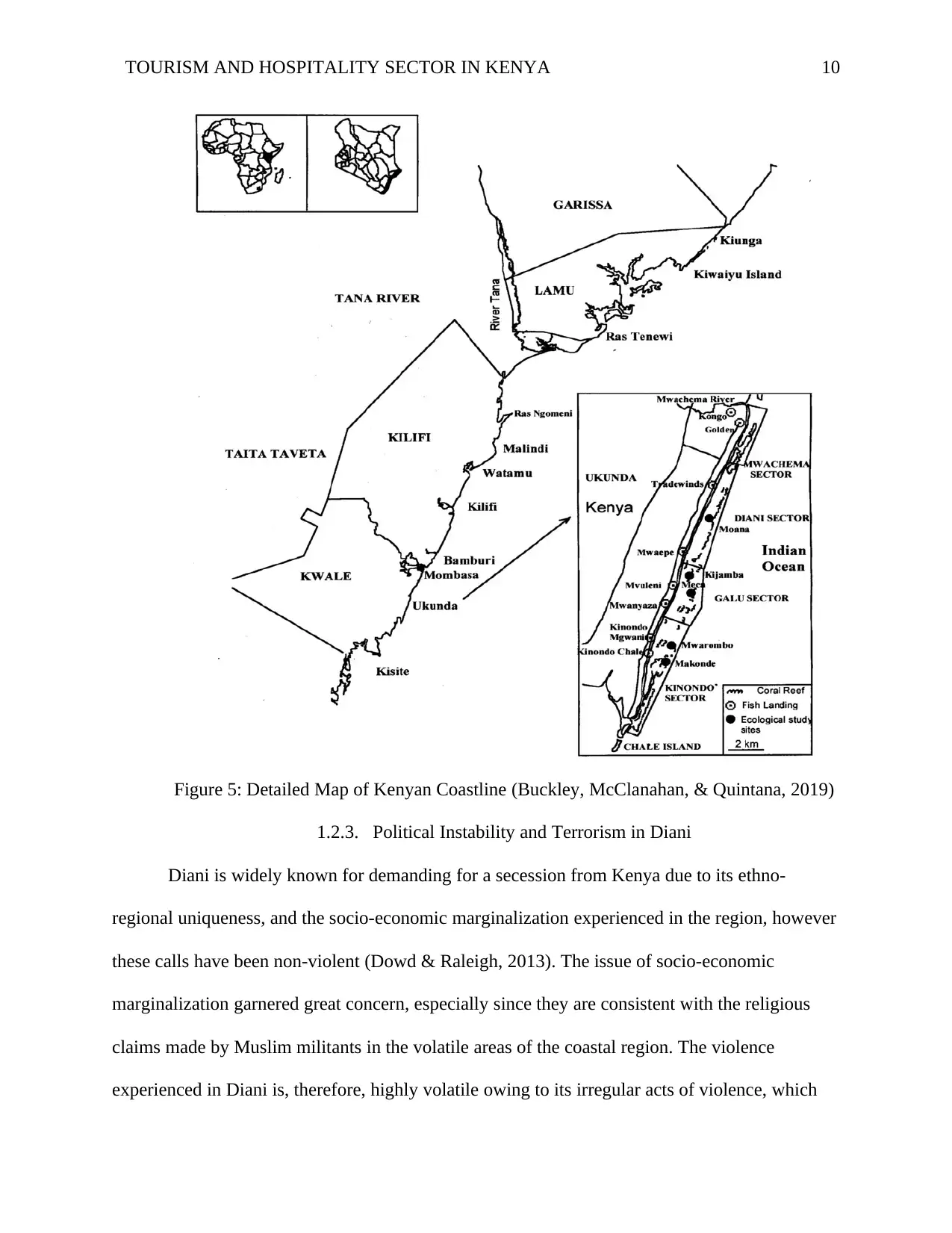
TOURISM AND HOSPITALITY SECTOR IN KENYA 10
Figure 5: Detailed Map of Kenyan Coastline (Buckley, McClanahan, & Quintana, 2019)
1.2.3. Political Instability and Terrorism in Diani
Diani is widely known for demanding for a secession from Kenya due to its ethno-
regional uniqueness, and the socio-economic marginalization experienced in the region, however
these calls have been non-violent (Dowd & Raleigh, 2013). The issue of socio-economic
marginalization garnered great concern, especially since they are consistent with the religious
claims made by Muslim militants in the volatile areas of the coastal region. The violence
experienced in Diani is, therefore, highly volatile owing to its irregular acts of violence, which
Figure 5: Detailed Map of Kenyan Coastline (Buckley, McClanahan, & Quintana, 2019)
1.2.3. Political Instability and Terrorism in Diani
Diani is widely known for demanding for a secession from Kenya due to its ethno-
regional uniqueness, and the socio-economic marginalization experienced in the region, however
these calls have been non-violent (Dowd & Raleigh, 2013). The issue of socio-economic
marginalization garnered great concern, especially since they are consistent with the religious
claims made by Muslim militants in the volatile areas of the coastal region. The violence
experienced in Diani is, therefore, highly volatile owing to its irregular acts of violence, which
Paraphrase This Document
Need a fresh take? Get an instant paraphrase of this document with our AI Paraphraser
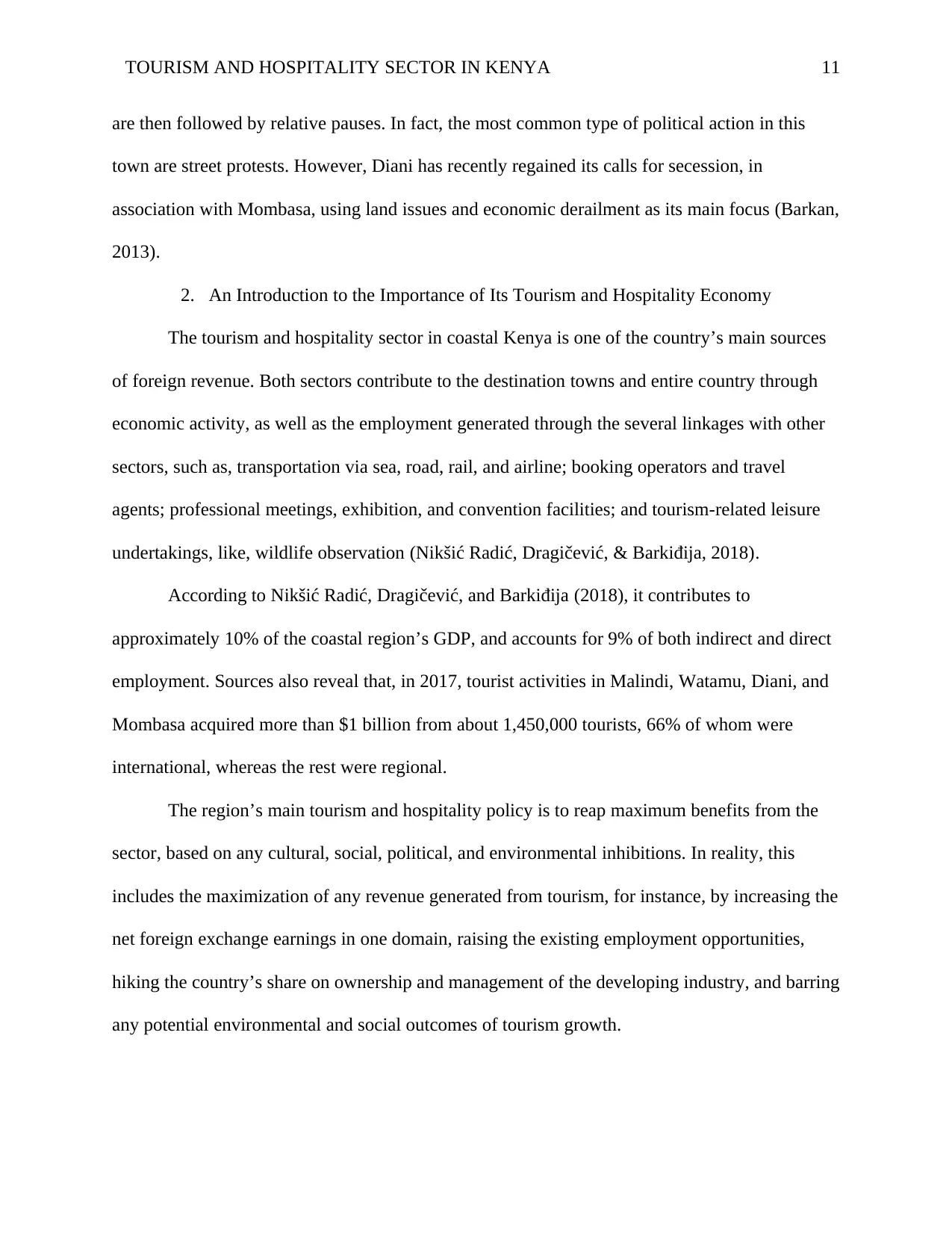
TOURISM AND HOSPITALITY SECTOR IN KENYA 11
are then followed by relative pauses. In fact, the most common type of political action in this
town are street protests. However, Diani has recently regained its calls for secession, in
association with Mombasa, using land issues and economic derailment as its main focus (Barkan,
2013).
2. An Introduction to the Importance of Its Tourism and Hospitality Economy
The tourism and hospitality sector in coastal Kenya is one of the country’s main sources
of foreign revenue. Both sectors contribute to the destination towns and entire country through
economic activity, as well as the employment generated through the several linkages with other
sectors, such as, transportation via sea, road, rail, and airline; booking operators and travel
agents; professional meetings, exhibition, and convention facilities; and tourism-related leisure
undertakings, like, wildlife observation (Nikšić Radić, Dragičević, & Barkiđija, 2018).
According to Nikšić Radić, Dragičević, and Barkiđija (2018), it contributes to
approximately 10% of the coastal region’s GDP, and accounts for 9% of both indirect and direct
employment. Sources also reveal that, in 2017, tourist activities in Malindi, Watamu, Diani, and
Mombasa acquired more than $1 billion from about 1,450,000 tourists, 66% of whom were
international, whereas the rest were regional.
The region’s main tourism and hospitality policy is to reap maximum benefits from the
sector, based on any cultural, social, political, and environmental inhibitions. In reality, this
includes the maximization of any revenue generated from tourism, for instance, by increasing the
net foreign exchange earnings in one domain, raising the existing employment opportunities,
hiking the country’s share on ownership and management of the developing industry, and barring
any potential environmental and social outcomes of tourism growth.
are then followed by relative pauses. In fact, the most common type of political action in this
town are street protests. However, Diani has recently regained its calls for secession, in
association with Mombasa, using land issues and economic derailment as its main focus (Barkan,
2013).
2. An Introduction to the Importance of Its Tourism and Hospitality Economy
The tourism and hospitality sector in coastal Kenya is one of the country’s main sources
of foreign revenue. Both sectors contribute to the destination towns and entire country through
economic activity, as well as the employment generated through the several linkages with other
sectors, such as, transportation via sea, road, rail, and airline; booking operators and travel
agents; professional meetings, exhibition, and convention facilities; and tourism-related leisure
undertakings, like, wildlife observation (Nikšić Radić, Dragičević, & Barkiđija, 2018).
According to Nikšić Radić, Dragičević, and Barkiđija (2018), it contributes to
approximately 10% of the coastal region’s GDP, and accounts for 9% of both indirect and direct
employment. Sources also reveal that, in 2017, tourist activities in Malindi, Watamu, Diani, and
Mombasa acquired more than $1 billion from about 1,450,000 tourists, 66% of whom were
international, whereas the rest were regional.
The region’s main tourism and hospitality policy is to reap maximum benefits from the
sector, based on any cultural, social, political, and environmental inhibitions. In reality, this
includes the maximization of any revenue generated from tourism, for instance, by increasing the
net foreign exchange earnings in one domain, raising the existing employment opportunities,
hiking the country’s share on ownership and management of the developing industry, and barring
any potential environmental and social outcomes of tourism growth.
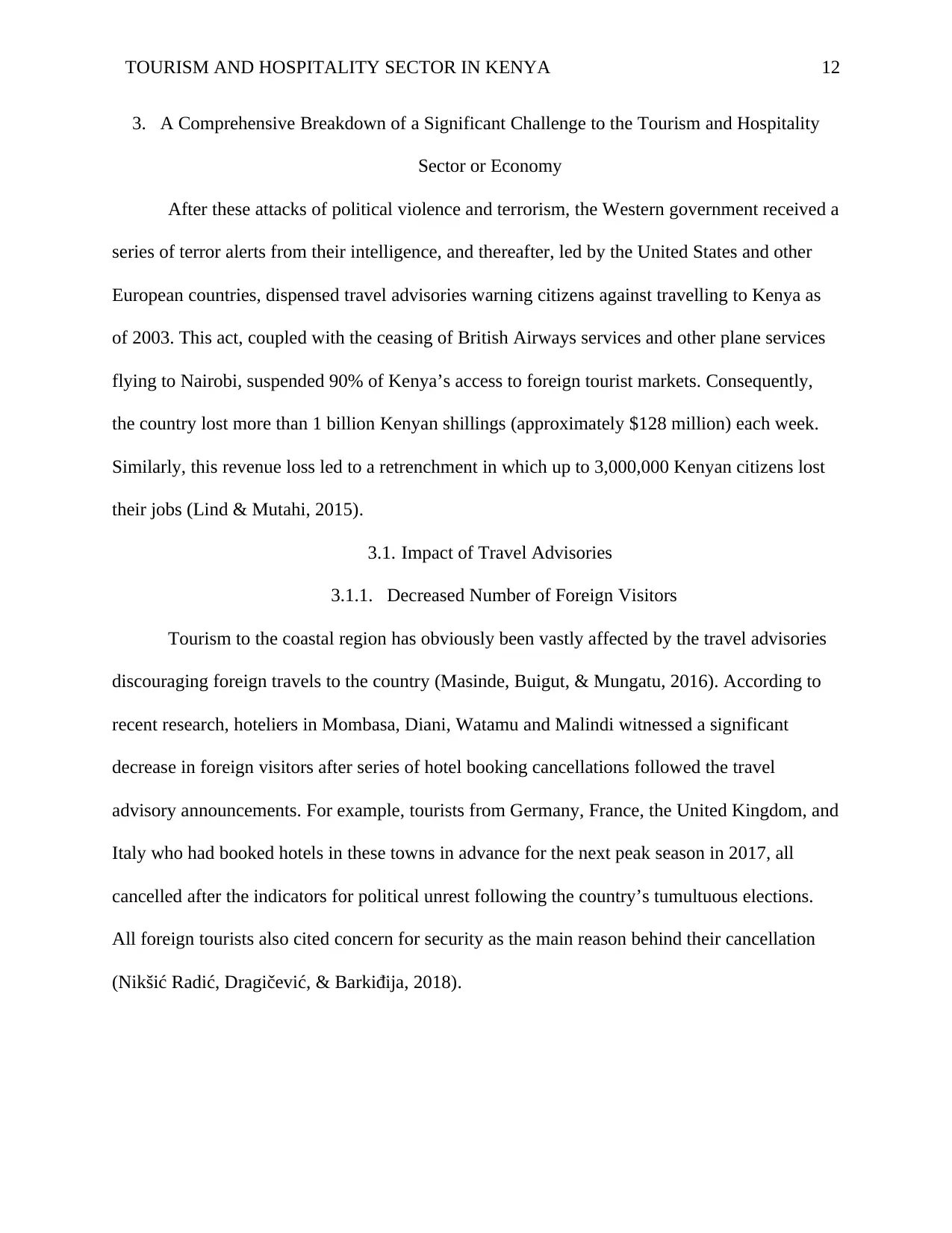
TOURISM AND HOSPITALITY SECTOR IN KENYA 12
3. A Comprehensive Breakdown of a Significant Challenge to the Tourism and Hospitality
Sector or Economy
After these attacks of political violence and terrorism, the Western government received a
series of terror alerts from their intelligence, and thereafter, led by the United States and other
European countries, dispensed travel advisories warning citizens against travelling to Kenya as
of 2003. This act, coupled with the ceasing of British Airways services and other plane services
flying to Nairobi, suspended 90% of Kenya’s access to foreign tourist markets. Consequently,
the country lost more than 1 billion Kenyan shillings (approximately $128 million) each week.
Similarly, this revenue loss led to a retrenchment in which up to 3,000,000 Kenyan citizens lost
their jobs (Lind & Mutahi, 2015).
3.1. Impact of Travel Advisories
3.1.1. Decreased Number of Foreign Visitors
Tourism to the coastal region has obviously been vastly affected by the travel advisories
discouraging foreign travels to the country (Masinde, Buigut, & Mungatu, 2016). According to
recent research, hoteliers in Mombasa, Diani, Watamu and Malindi witnessed a significant
decrease in foreign visitors after series of hotel booking cancellations followed the travel
advisory announcements. For example, tourists from Germany, France, the United Kingdom, and
Italy who had booked hotels in these towns in advance for the next peak season in 2017, all
cancelled after the indicators for political unrest following the country’s tumultuous elections.
All foreign tourists also cited concern for security as the main reason behind their cancellation
(Nikšić Radić, Dragičević, & Barkiđija, 2018).
3. A Comprehensive Breakdown of a Significant Challenge to the Tourism and Hospitality
Sector or Economy
After these attacks of political violence and terrorism, the Western government received a
series of terror alerts from their intelligence, and thereafter, led by the United States and other
European countries, dispensed travel advisories warning citizens against travelling to Kenya as
of 2003. This act, coupled with the ceasing of British Airways services and other plane services
flying to Nairobi, suspended 90% of Kenya’s access to foreign tourist markets. Consequently,
the country lost more than 1 billion Kenyan shillings (approximately $128 million) each week.
Similarly, this revenue loss led to a retrenchment in which up to 3,000,000 Kenyan citizens lost
their jobs (Lind & Mutahi, 2015).
3.1. Impact of Travel Advisories
3.1.1. Decreased Number of Foreign Visitors
Tourism to the coastal region has obviously been vastly affected by the travel advisories
discouraging foreign travels to the country (Masinde, Buigut, & Mungatu, 2016). According to
recent research, hoteliers in Mombasa, Diani, Watamu and Malindi witnessed a significant
decrease in foreign visitors after series of hotel booking cancellations followed the travel
advisory announcements. For example, tourists from Germany, France, the United Kingdom, and
Italy who had booked hotels in these towns in advance for the next peak season in 2017, all
cancelled after the indicators for political unrest following the country’s tumultuous elections.
All foreign tourists also cited concern for security as the main reason behind their cancellation
(Nikšić Radić, Dragičević, & Barkiđija, 2018).
⊘ This is a preview!⊘
Do you want full access?
Subscribe today to unlock all pages.

Trusted by 1+ million students worldwide
1 out of 18
Your All-in-One AI-Powered Toolkit for Academic Success.
+13062052269
info@desklib.com
Available 24*7 on WhatsApp / Email
![[object Object]](/_next/static/media/star-bottom.7253800d.svg)
Unlock your academic potential
Copyright © 2020–2025 A2Z Services. All Rights Reserved. Developed and managed by ZUCOL.